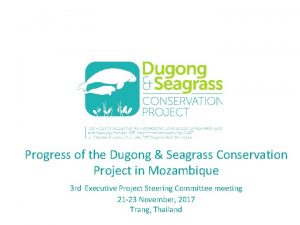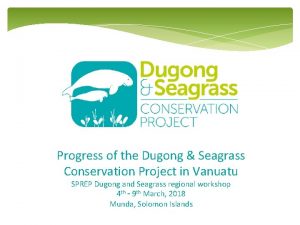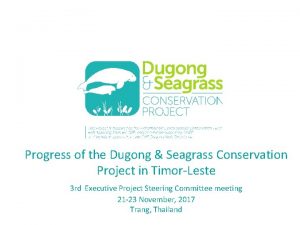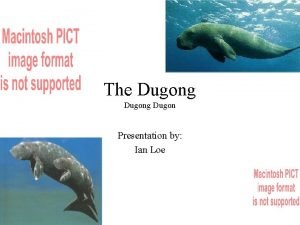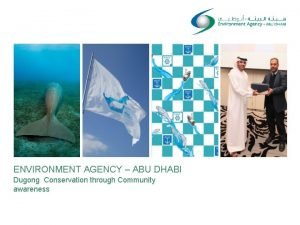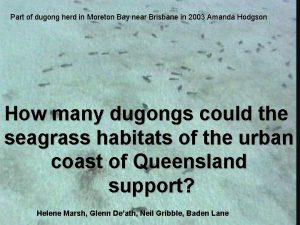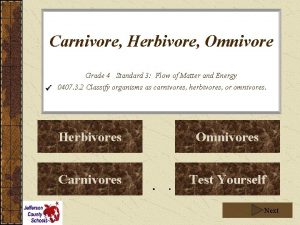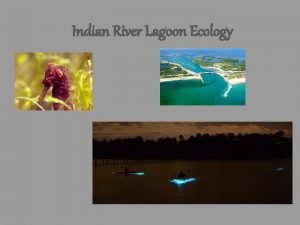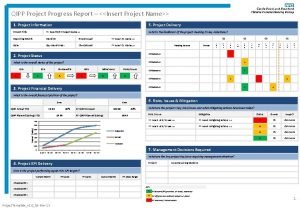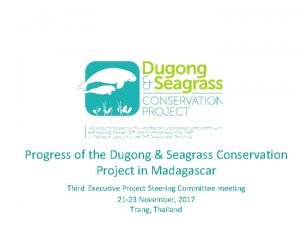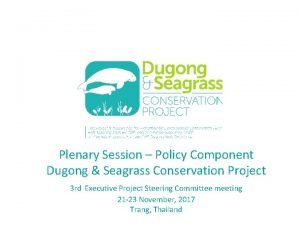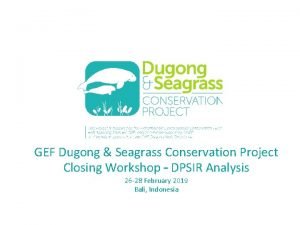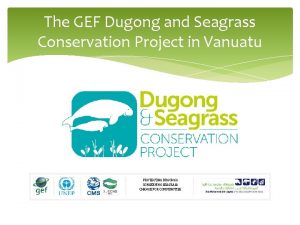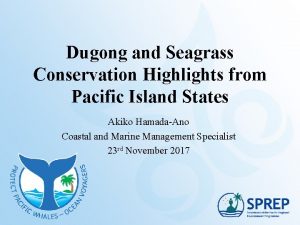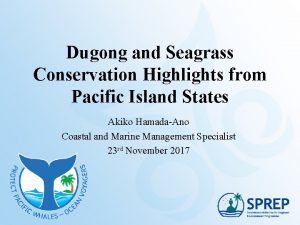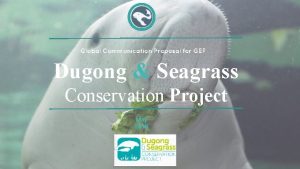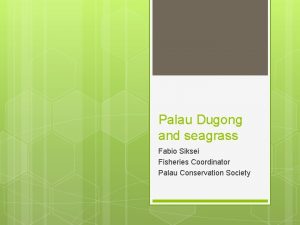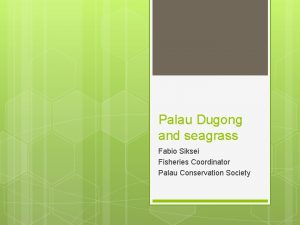Progress of the Dugong Seagrass Conservation Project in












- Slides: 12

Progress of the Dugong & Seagrass Conservation Project in Timor-Leste 3 rd Executive Project Steering Committee meeting 21 -23 November, 2017 Trang, Thailand

Project Partners in Timor-Leste

Past, present and future of dugong and seagrass conservation in Timor-Leste Baseline in 2015 • Dugongs: limited information generated in 1999 • Seagrass: scattered/ no data – latest data since 2006 • Communities: community-based monitoring/ management structures exists but not integrating dugongs • Incentives: 1 incentive model based on food security for community-based conservation, no public subsidies • Policies: Dugong Mo. U not signed, no integrated policy for dugong and seagrass Progress by 2017 • Dugongs: maps/ data on distribution, threats, occurrence for 4 sites • Seagrass: maps/ data on composition, distribution, use, or abundancy for 12 sites • Policies: 2 draft sectoral policies on integrating dugongs and seagrasses into development planning and tourism • Communities: 3 communities in 4 sites, participate in dugong hotspots management/ monitoring; • Incentives: 3 incentives models based on food security, fees, and home stays communities in 8 sites, including local women involvement Targets for 2018 • Dugongs: 1 dedicated MPA for dugong and seagrass; baseline database submitted to govt • Seagrass: baseline database and national maps submitted to govt and available for stakeholders • Policies: draft dugong watching guidelines incorporated into tourism policy, recommendations for 2 sectoral policies on integrating dugongs and seagrasses into development planning • Communities: 16 communities participate in monitoring/ management of dugong/ seagrass hotspots • Incentives: 3 incentives models are expanded into an additional 4 communities, and incorporated into the draft tourism plan

Results from dugong research in Timor-Leste Research Questions q What is the dugong population size? q Where are their main habitats? – 2015 dugong population unknown except for one dugong frequenting Dili the capital • Modified version of the Short Dugong Questionnaire implemented in 11 Municipalities – Full analysis not completed and further surveys need to be carried out • Initiating drone use on the isolated coastal areas • Results showed dugong sightings on both north and south coasts, but regular sightings in only 4 communities (3 Municipalities) ©Jason Isley

Results from dugong research in Timor-Leste Research Questions q What is the dugong population size? q Where are their main habitats? – 2017 dugong information – • Dugong are considered to hold the spirit of ancestors, so are not hunted, every community has a different local name • Four communities on the mainland report regular sightings of dugong. One community had never seen a dugong and didn’t know what it was when shown an image. • One community with regular visits from a group of 2 to 5 dugongs in their MPA • Same community has identified a new area for dugong which the community wish to develop into a dugong and seagrass MPA • Concerns over the Dili dugong “Doug” due to a major development on shore. Poor communications and enforcement between government agencies has seen the developer encroach on the MPA and seagrass • Timor-Leste dugong displaying behavior not recorded elsewhere according to Proff Helene Marsh ( video) 2018 dugong work • Complete the demarcation and formalization of the dugong MPA ( 2000 ha) • Continue survey actions, analyze data, and complete mapping

Results from seagrass research in Timor-Leste Research Questions q What species exist in Timor-Leste? q What is the extent of the seagrass beds (ha)? q Where is the seagrass located including depth? – 2017 Seagrass Watch methodology was implemented

Results from seagrass research in Timor-Leste Research Questions q What species exist in Timor-Leste? q What is the extent of the seagrass beds (ha)? q Where is the seagrass located including depth? – 2015 no seagrass research had been undertaken – 2017 • Implemented Seagrass Watch methodology – Built into community MPA monitoring plan – Paid data collectors under the incentive project (modified version) – Trained government staff • Used social media images to identify species (Len Mc. Kenzie) – Full analysis not completed and further surveys need to be carried out • Limited mapping of seagrass has occurred as it requires trained divers to access the deeper areas. Seagrass beds are small and fragmented in between reef, mangrove, and mud/rocky areas. Communities can only monitor the shallow zones • Coastal map is being developed combining several projects data sets – first for Timor-Leste • Communities happy to monitoring seagrass as part of the MPA monitoring

Project policy response to dugong & seagrass conservation needs in Timor-Leste – 2015 no specific dugong or seagrass policy – 2017 gap analysis completed – – No policies exist nationally for dugong and it was difficult to find anything in region or globally which could be used as an example Whale watching Guidelines being developed in Timor-Leste will include dugong – There is a need to create dugong specific guidelines for tourism – Seagrass and dugong guidelines need to be developed for coastal development – Education and awareness training for government staff in the Planning, Protection, and Tourism ministries is vital to gain broad understanding of why guidelines are needed – Threats • • • Damage to seagrass through boat mooring and netting Potential for increased damage to seagrass as coastal development increases Little to no issue from land based sediment or pollution Dugong are protected culturally Strandings of cetaceans or dugong is rare in Timor-Leste

Community-based stewardship of dugongs and their seagrass habitats – 2015 • no dedicated dugong community based action, • 3 communities active in protecting seagrass in their MPA’s • 1 incentive program based on food security in place to support community based environment protection – 2017 • 12 communities active in protecting seagrass through MPA creation, • 1 community identified an area to be developed into a dugong specific MPA • 3 incentives being used for community based environment protection – 2 developed by the communities themselves – 1 introduced through the project

Timor-Leste lessons learned • It was bigger than anyone thought – Needed an in-country dedicated Project Manager – low capacity/not a priority – With no existing work in this area, everything needed to be developed from scratch which required a higher level of funding – It was not a priority for the new country so has been difficult to get govt ownership – The questions raised about the dugong have left the partners in a situation of “what now” – Fragmentation of the coastal ecosystems has restricted the ability of the project to map seagrass nationally – Implementing the questionnaire needed 100 well trained people. • The results are not what the project was expecting – Project incentive model is good, but is reliant on the partner to implement so communities have not adopted it – Communities have developed their own incentives and through peer to peer learning they are being adopted nationally – Community at the eastern tip of the island do not know what a dugong is • Not sustainable in the short term – No govt funding available – it will be donor dependent – Difficult for govt to monitor or enforce policy (who owns it? ) – Monitoring built into existing actions such as community MPA monitoring is sustainable – Incentives owned and managed by the communities are sustainable, but the project incentive model is partner dependent

Next steps • Awareness campaign nationally – Project partners engaged a photographer to secure images and footage of seagrass, project activities and dugong – Producing communications materials • Analyzing the data collected and mapping the results

 Dugong and seagrass conservation project
Dugong and seagrass conservation project Dugong and seagrass conservation project
Dugong and seagrass conservation project Dugong and seagrass conservation project
Dugong and seagrass conservation project Physical progress and financial progress
Physical progress and financial progress Dugong biome
Dugong biome Dugongs in uae
Dugongs in uae Dugong moreton bay
Dugong moreton bay Is a frog a herbivore carnivore or omnivore
Is a frog a herbivore carnivore or omnivore Dugong herbivore or omnivore
Dugong herbivore or omnivore Indian river lagoon seagrass
Indian river lagoon seagrass Qipp agenda
Qipp agenda Measuring project progress
Measuring project progress Engineering final year project presentation sample
Engineering final year project presentation sample
